YouTube has over 2.4 billion monthly users, so it’s no surprise that standing out can be tough. With so many videos uploaded daily, getting noticed takes more than just great content.
One way to improve your reach is by using a YouTube keyword planner. This tool helps you find the best keywords for your video titles, descriptions, and tags, making it easier for people to find your content.
The right keywords can bring in the right audience, help YouTube understand your video, and increase views over time. Since YouTube’s algorithm uses keywords to recommend videos, choosing them smartly can make a big difference.
In this guide, we’ll tell you about the best keyword planner for YouTube and how to use it to increase your visibility and grow your subscriber base.
What are YouTube keywords, and why do they matter?
You’ve probably heard the term keywords plenty of times. But what exactly are they?
On YouTube, a keyword is simply a group of words people type in when searching for videos.
If you watch YouTube often, you’re already using keywords without realizing it. Every time you type something into the search bar, you’re giving YouTube clues about what you want to watch.
For example, try searching for “hot chocolate.” You’ll see YouTube not only pull up related videos but also suggest similar searches you might find useful.
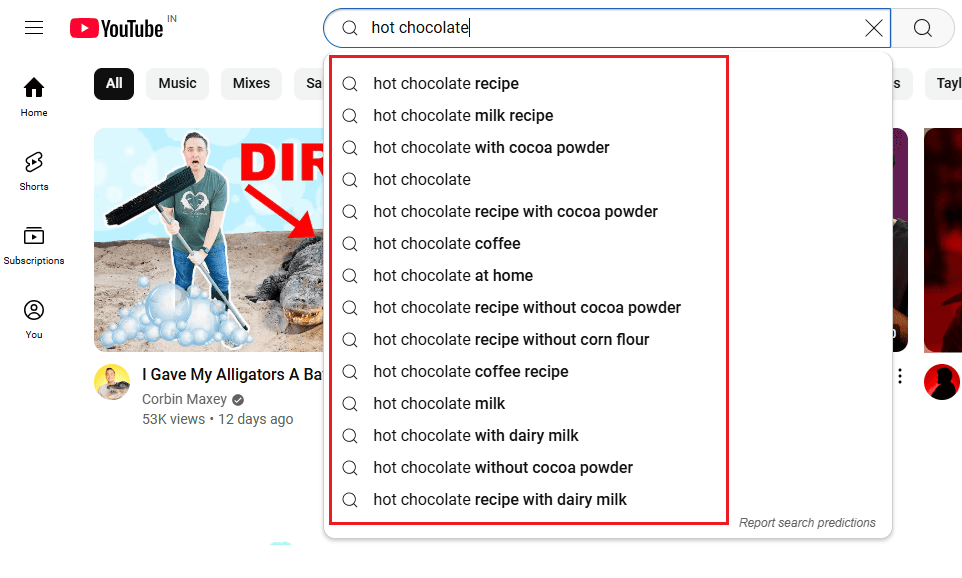
These words and phrases—also known as YouTube keywords, search terms, or search queries—can help you optimize your videos to rank higher in search results.
This strategy can increase brand awareness, improve video performance, and drive traffic to your website (or channel).
Doing keyword research also helps you understand what your target audience is actually looking for.
If you create content that matches their searches, your videos have a better chance of appearing in results—leading to more views, more engagement, and more subscribers.
Understanding The YouTube Algorithm
When we talk about YouTube, we’re looking at more than just a video-sharing platform—it’s the second-most visited website in the world.
But how does YouTube decide which videos get millions of views and which ones barely get noticed?
That’s where the YouTube algorithm comes in. This smart system determines what content gets recommended, ranked, and ultimately seen by users.
The algorithm is mainly driven by two key factors: relevance and engagement. Your video needs to be relevant to what users are searching for and engaging enough to keep them watching.
Here are some of the factors the YouTube algorithm considers when ranking videos:
- Click-through rate (CTR) – How often people click on your video after seeing it
- Watch time – For how long viewers stay on your video
- Video length – Longer videos can perform well, but only if they keep viewers engaged
- User engagement – Likes, comments, shares, and subscriptions all play a role
At the core of it all, YouTube wants to keep users on the platform for as long as possible by showing them content they’ll enjoy.
The more your video helps with that goal, the more likely it is to be recommended and ranked higher in search results.
Why do you need a keyword planner for YouTube?
A YouTube keyword planner is useful because it helps you find the right terms to create videos that match what your audience is searching for.
By focusing on these search queries, you can optimize your content for video SEO—a set of strategies that improve your rankings on both YouTube and Google.
This includes using keywords in video titles, descriptions, and tags to make your content easier to find.
An effective YouTube keyword planner can help you:
- Create videos that align with what viewers are actively searching for
- Optimize your content with relevant keywords to grow your subscriber base
By understanding what people are looking for, you can make videos that attract the right audience and perform better in search results.
Which is the best keyword planner for Youtube?
With so many keyword planners available, choosing the right one can be overwhelming.
While most tools offer features like search volume, keyword trends, ranking difficulty, and competition analysis, not all of them cover everything.
Some, like Rank Tracker for YouTube, focus on specific functions—such as tracking where your videos rank in search results.
One of the best tools for YouTube keyword research and planning is Keywords Everywhere.
And don’t just take our word for it—even well-known SEO brands like Semrush and Neil Patel have recommended it as one of the top tools for YouTube keyword research.
So what makes Keywords Everywhere stand out?
It’s a browser extension that provides key insights directly within YouTube’s search results. When you search for a topic, it displays useful metrics.
That includes:
- Search volume – How often a keyword is searched
- Cost per click (CPC) – What advertisers pay for that keyword
- Search trends – Popularity of the keyword over the last 12 months
- Ranking difficulty – How competitive a keyword is
- Top channels – The most influential creators using that keyword
- Maximum and average views – Performance insights for videos ranking on that keyword
- SEO score – How well a video is optimized for search
- Engagement score – Interaction levels (likes, comments, shares)
- People also search for – Related keyword suggestions
- Most used tags – Common tags appearing in top videos
What’s useful about Keywords Everywhere is that it integrates directly into YouTube. Each time you search for a term, it scans the results and provides a widget with valuable data—like how many videos include that keyword in their title, the average views for top-ranking videos, and more.
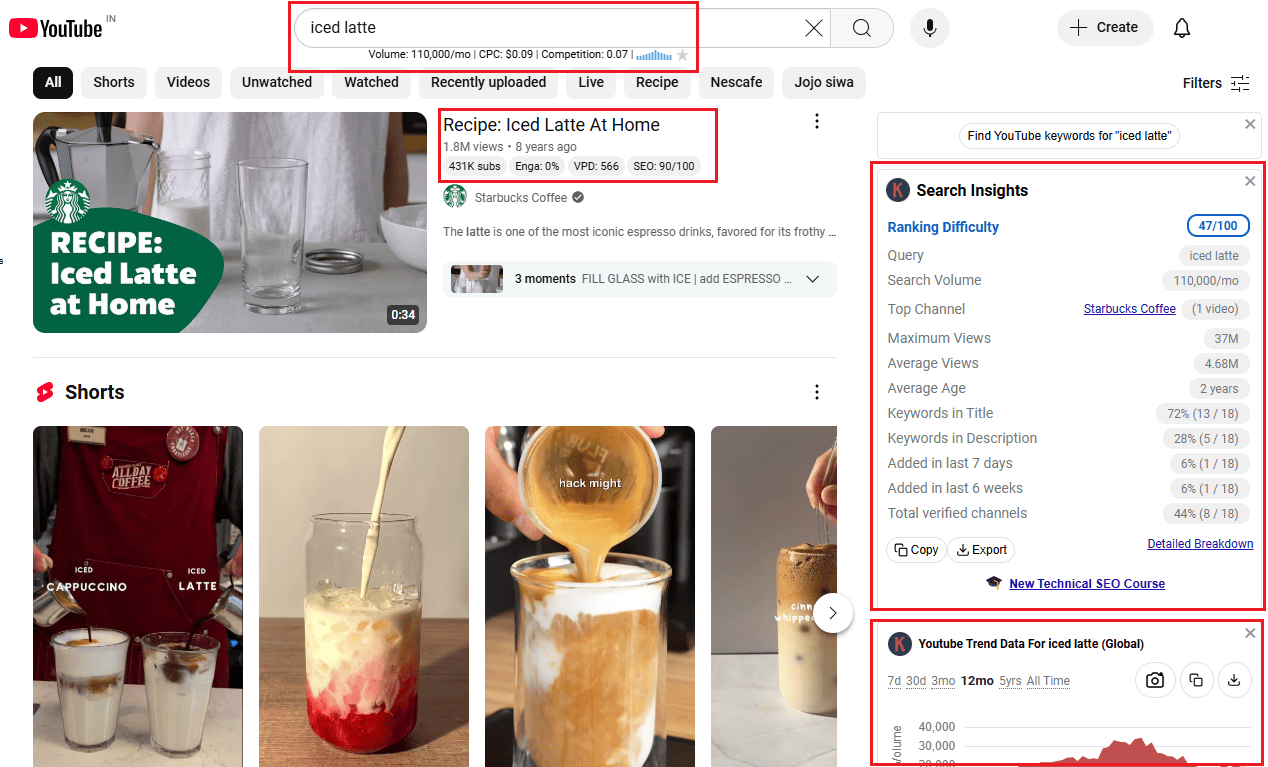
This makes keyword research faster and more efficient, helping you find less competitive yet highly relevant keywords for your niche.
How to use Keywords Everywhere for YouTube keyword planning?
If you’re familiar with Google SEO, it’s important to know that keyword planning for Google and other search engines isn’t the same as YouTube keyword research and planning.
What people search for on YouTube can be quite different from what they look up on Google.
When users come to YouTube, they’re usually looking for videos that educate, entertain, solve a problem, or satisfy their curiosity.
This means their search terms are specifically geared toward video content—think “how to make iced coffee” or “latest iPhone features.”
But here’s where things get interesting. In YouTube SEO, we often come across what can be called “video-specific” keywords—terms like “tutorial,” “review,” “demo,” or “step-by-step.”
These might not be as popular on Google, but they’re incredibly valuable on YouTube.
The key is understanding that viewers are searching for video answers, and your content needs to deliver exactly that.
So how do you officially start your YouTube keyword planning process? Here’s a step-by-step guide to help you get started:
1. Understand Short-Tail vs. Long-Tail Keywords
When it comes to keywords, it’s all about finding the correct balance between search volume and competition.
Short-tail keywords are broad and often have high search volumes but come with intense competition.
For example, a keyword like “fitness” is extremely popular, meaning millions of videos are competing for the same audience.
On the other hand, long-tail keywords are more specific and detailed—think “10-minute home workout for beginners”.
While these types of keywords may have lower search volumes, they also have less competition, making it easier for your video to rank and attract viewers.
The goal is to find keywords that sit in the sweet spot—enough search volume to attract views (between 1,000 and 5,000 monthly searches) but not so competitive that your video gets buried under thousands of results.
This is where Keywords Everywhere comes in. Install the browser extension from Chrome, turn it on, and head over to YouTube.
Search for your seed keyword (we used “productivity” as an example), and you’ll see a list of relevant keywords with their search volume, CPC, competition level, and trend data.
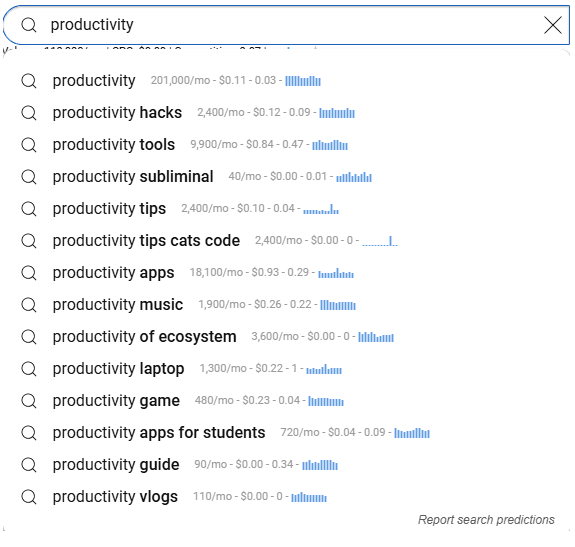
Now, look for keywords that fall within the 1,000-5,000 monthly search range. These are the ones that strike the perfect balance between visibility and ranking potential.
Keywords like “productivity hacks,” “productivity tips,” and “productivity music” fit right into this sweet spot. Write all these in a sheet and make content around these keywords.
2. Find and Choose Relevant Keywords
The golden rule of YouTube keyword research? Relevance.
Your chosen keywords must accurately reflect what your video is about and who it’s meant for. This means you need to understand your content and know your target audience fully.
The more relevant your keywords are, the better your chances of attracting viewers who are truly interested in your content.
Relevant keywords lead to longer watch times, higher engagement rate, and a stronger connection with your target audience. If your keywords don’t match what users are looking for, your video may get buried in the search results.
If you’re unsure whether your keyword is relevant, a good trick is to check the top-performing video for that keyword.
For instance, when we searched for “How to do squats,” which has around 12,000 monthly searches, we found a top-ranking video on “How To Squat Properly: 3 Mistakes Harming Your Lower Back.”
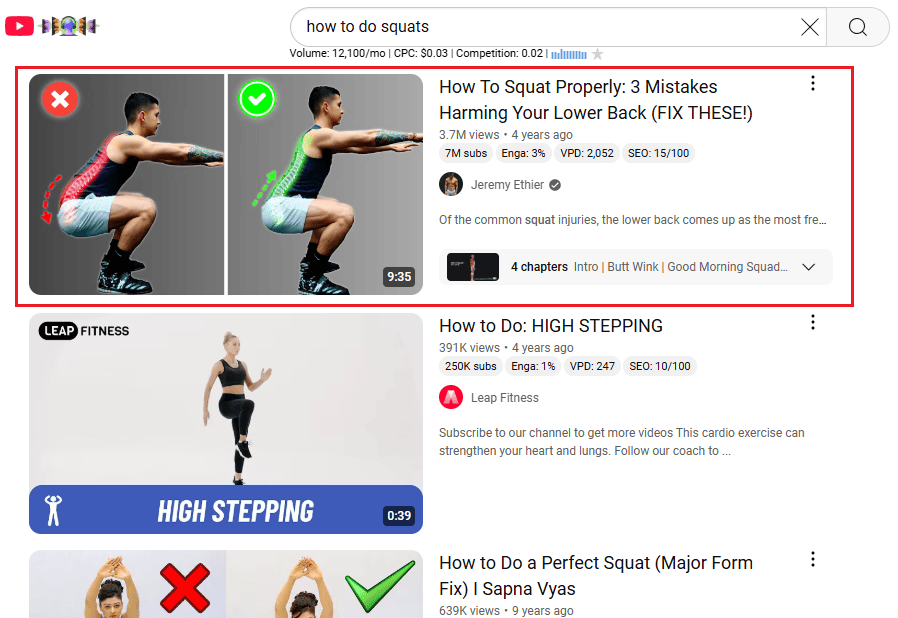
When you open this video, you’ll see a widget on the right side of the screen, which shows important metrics like views per day, engagement score, and more.
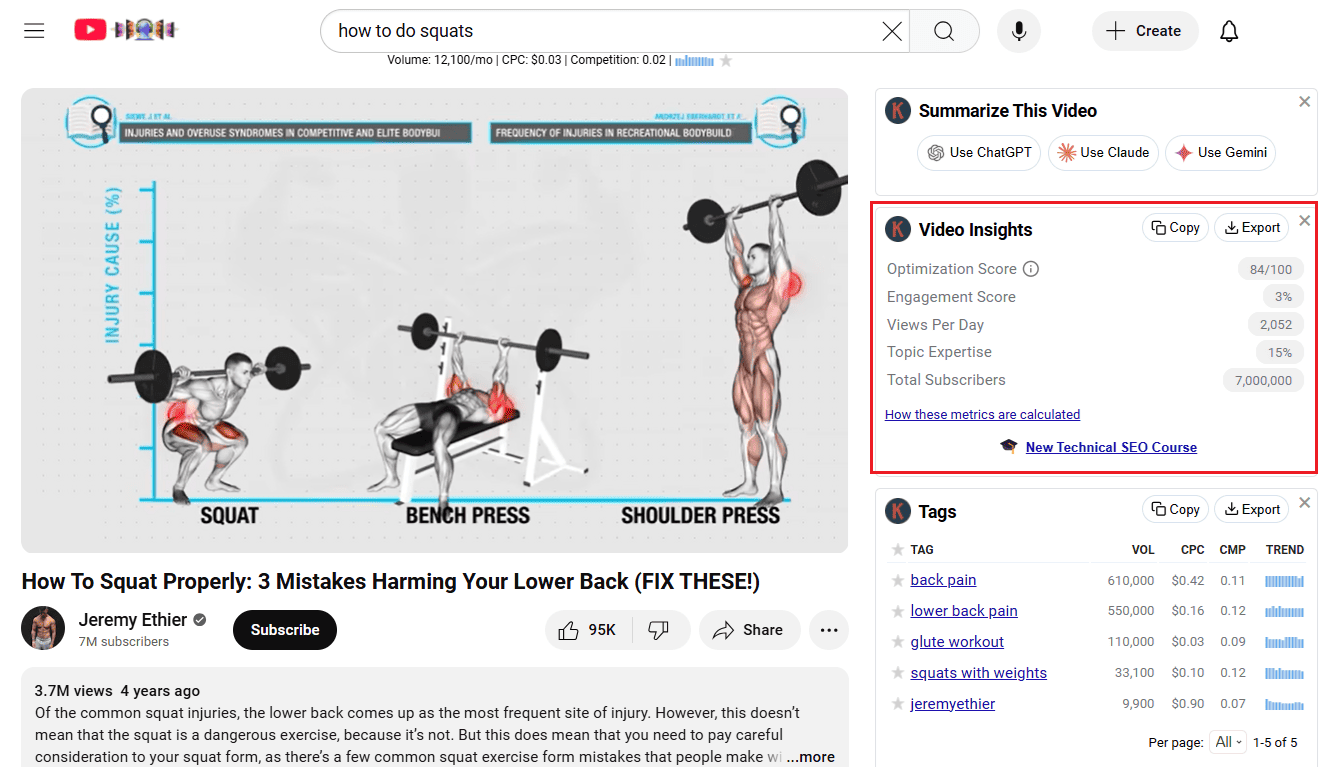
This particular video is getting 2,052 views every single day, which indicates that it’s highly relevant to people searching for “how to do squats.”
If you want to target people searching for how to do squats, creating a similar video would increase your chances of ranking higher because it would resonate well with viewers and match their search intent.
3. Analyze Search Intent
When it comes to YouTube, understanding search intent is all about knowing what your viewers are truly looking for.
Are they searching to learn something new, solve a problem, get entertained, or simply find a product review?
The key to successful keyword planning lies in figuring out that intent.
When you can understand what your audience is hoping to find, you can pick the right keywords that reflect their needs and match your video content.
If you focus on the relevance of your keywords and align them with search intent, your videos are more likely to perform better.
By doing so, you create content that directly answers your audience’s questions, addresses their pain points, and fits into their search journey.
This not only boosts engagement but helps build a stronger relationship with your viewers.
For example, let’s say you’re a travel blogger, and you’re creating a video about “places in New York to visit.” To figure out what users are really looking for, you can check the top-ranking videos for this keyword.
Search for “places in New York to visit” on YouTube. You’ll see a “Search Insights” widget on the right side of your screen.
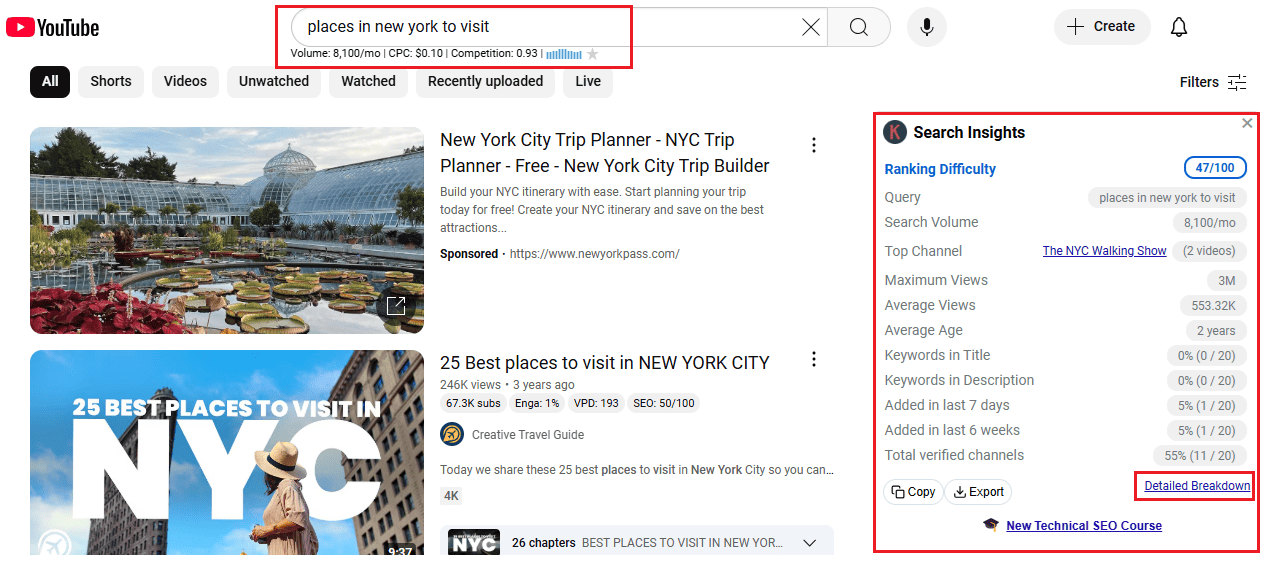
Click on the “detailed breakdown” option, and you’ll get a list of ranking videos along with important metrics such as views per day, subscribers, engagement score, SEO score, and more.
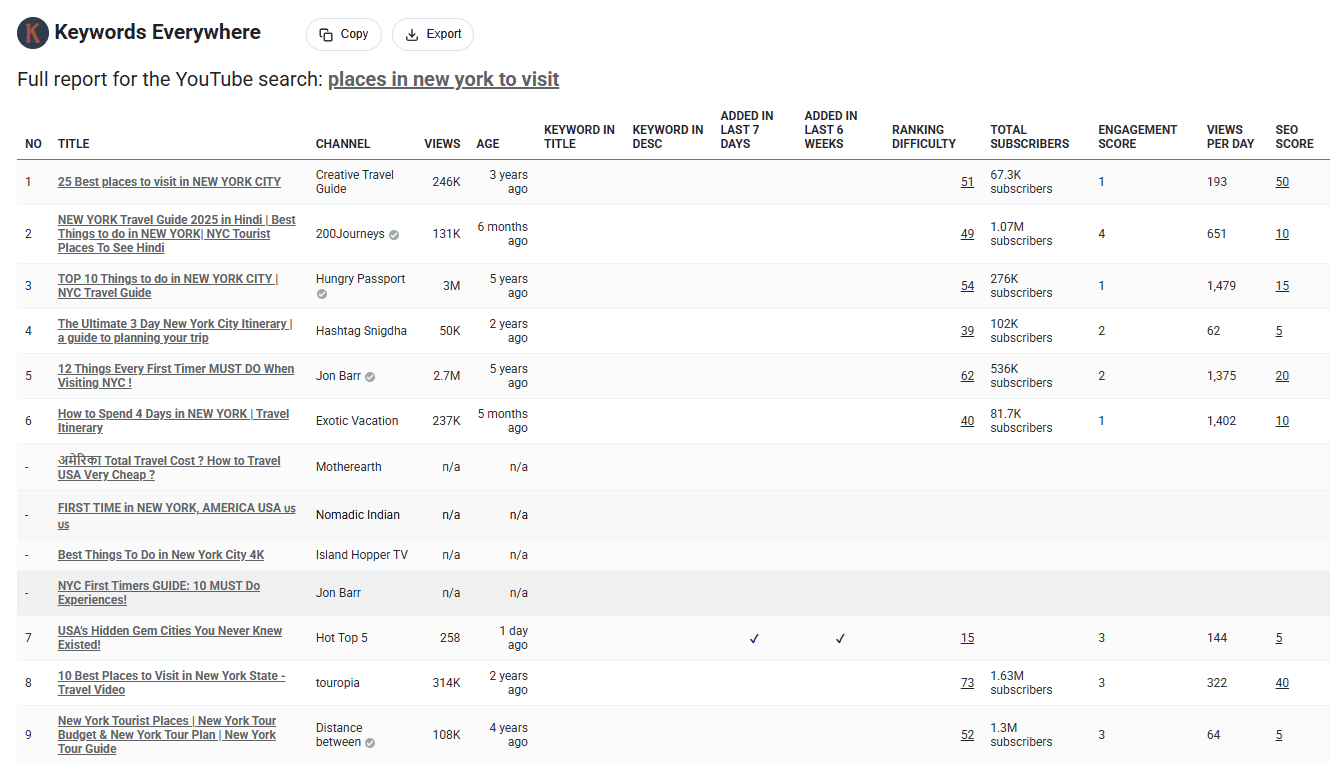
By looking at the video titles, you’ll notice that most top-ranking channels have covered topics like “Top things to do in New York City.”
This indicates that when people search for “places in New York to visit,” they’re also expecting to see a list of things to do and places to explore, not just a list of sites to visit.
Now, if you make a video that combines both—places to visit AND things to do in New York—you’re more likely to satisfy what your audience is looking for, ultimately helping your video rank better.
4. Check Keyword Competition
When it comes to YouTube keyword planning, understanding the competition is just as important as knowing the search volume.
Once you’ve generated your keyword ideas, take a look at the top-ranking videos for those keywords. Pay attention to the keywords they’re using and how they’re covering the topic.
But it’s not just about looking at the top videos—it’s about doing a qualitative assessment.
Creating a video can be a time-consuming and expensive process, so it’s important to understand what’s already out there and figure out what unique angle or fresh approach you can bring to the table.
Ask yourself, “Can I do better?” Could you improve the production quality, offer a new perspective, or present the topic in a more engaging way?
To help you assess the competition, you can score the top-ranking videos on a scale from 1-10:
- 1-4 if they don’t effectively satisfy the search intent
- 5-7 if they cover some aspects well but miss others
- 8-10 if they’re high-quality and engaging from start to finish
This isn’t an exact science—it’s just a way to gauge how well these videos are meeting the searcher’s needs.
If most videos score 8-10, it could be tough to get noticed with similar content. On the other hand, if the videos aren’t hitting the mark, that’s your opportunity to create something better.
Remember, you don’t have to completely avoid topics that others are doing well; it’s just about knowing where you can make an impact.
This approach is especially useful if you’re starting and want to prioritize topics with less competition but high demand.
To measure the competition quantitatively, you can use Keywords Everywhere.
Our tool will show you important metrics like Ranking Difficulty, top channels, and verified channels, giving you deeper insights into how competitive a keyword really is.
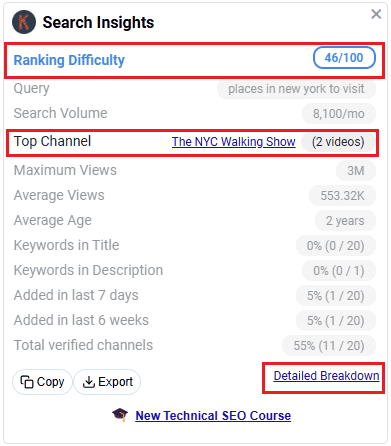
5. Understand YouTube-Specific Metrics
When using a keyword planner for YouTube, you’ll come across various metrics. Understanding what each metric means and which ones matter for keyword planning is key.
Let’s say you’re starting a channel focused on coffee recipes and want to create a video on making iced coffee.
To begin your keyword planning, search for “iced coffee” on YouTube. You’ll see that this keyword has a monthly search volume of 301,000, meaning it’s highly competitive.

Ranking for it won’t be easy, so you need to go deeper and analyze other important metrics.
Some key factors to look at include Ranking Difficulty, Top Channels, Views per video, Video Age (when it was posted), and Keyword Placement (whether the keyword appears in the video title and description).
You can find all of this on the widget displayed on the right side of your screen, which also shows maximum and average views, how many ranking channels are verified, and other valuable insights (see below).
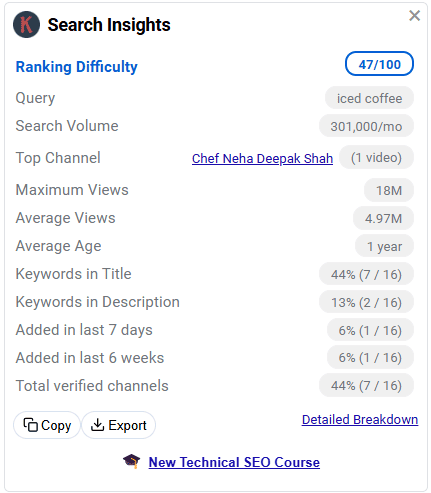
Scrolling further, you’ll find the most used tags for videos related to “iced coffee.” Copy or export all these tags and include them in your video description.
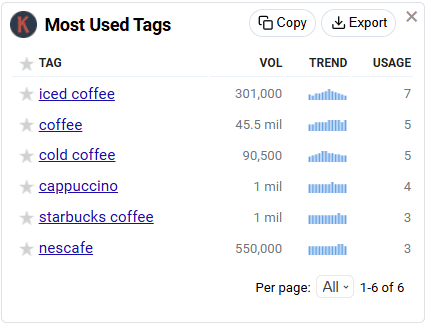
Just like you use secondary keywords alongside primary ones in SEO, using relevant tags in your description can boost your video’s discoverability on YouTube.
To refine your keyword research, analyze the top-ranking videos for your keyword. This helps you understand what viewers want to see and how you can create better content.
Click on any top-ranking video, and you’ll notice a video insights widget on the right.
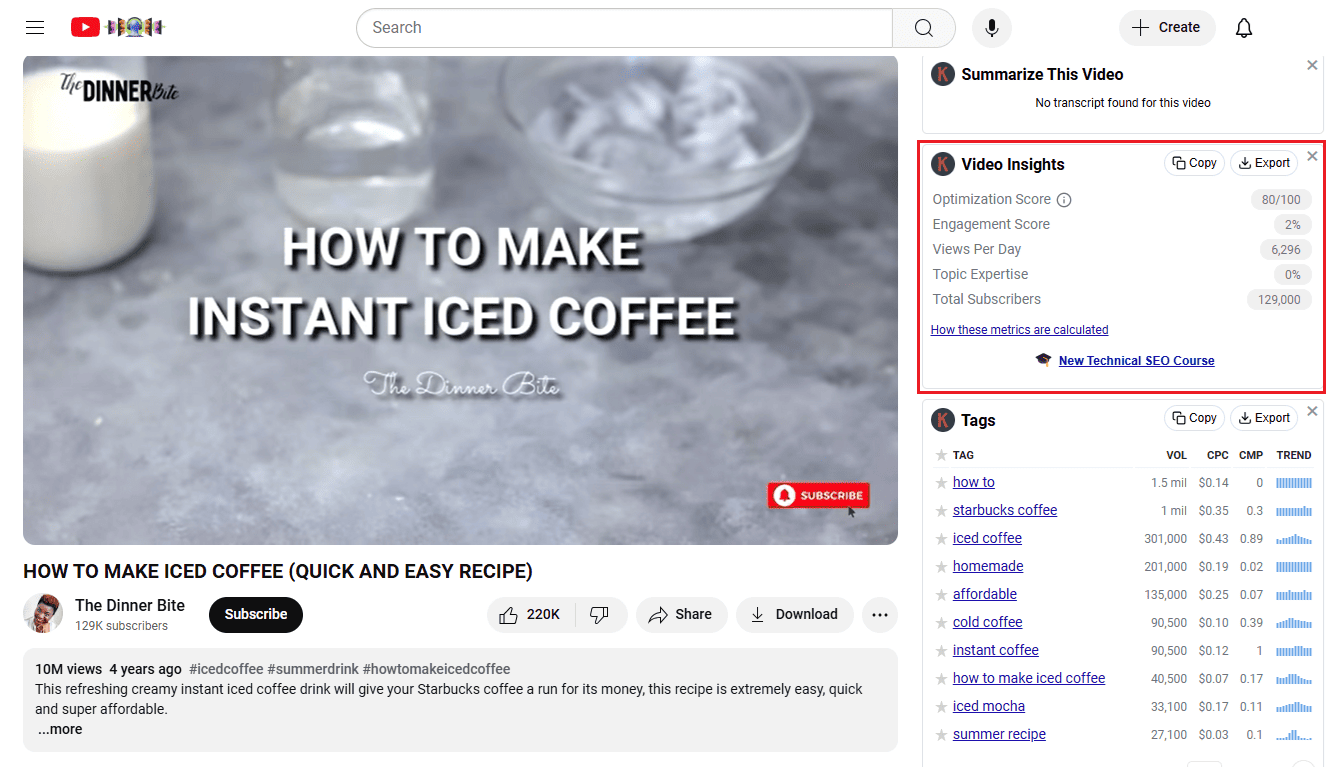
This widget provides key data such as Optimization Score (which evaluates video length, quality, total tags, etc), Engagement Score, Views per day, Topic Expertise, and Total Subscribers. You can even export this data to analyze later.
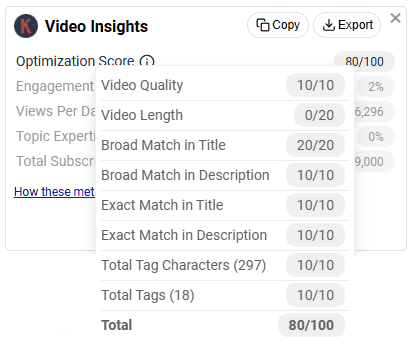
Study at least 3-4 top-ranking videos to see what’s working, where competitors fall short, and how you can improve upon their content.
This will help you decide whether to target the keyword or find an alternative with less competition.
If you don’t have time to check each video individually, Keywords Everywhere provides a shortcut.
Right below every video title, you’ll see four essential metrics: Total Subscribers, Engagement Score, Views per Day, and SEO Score.
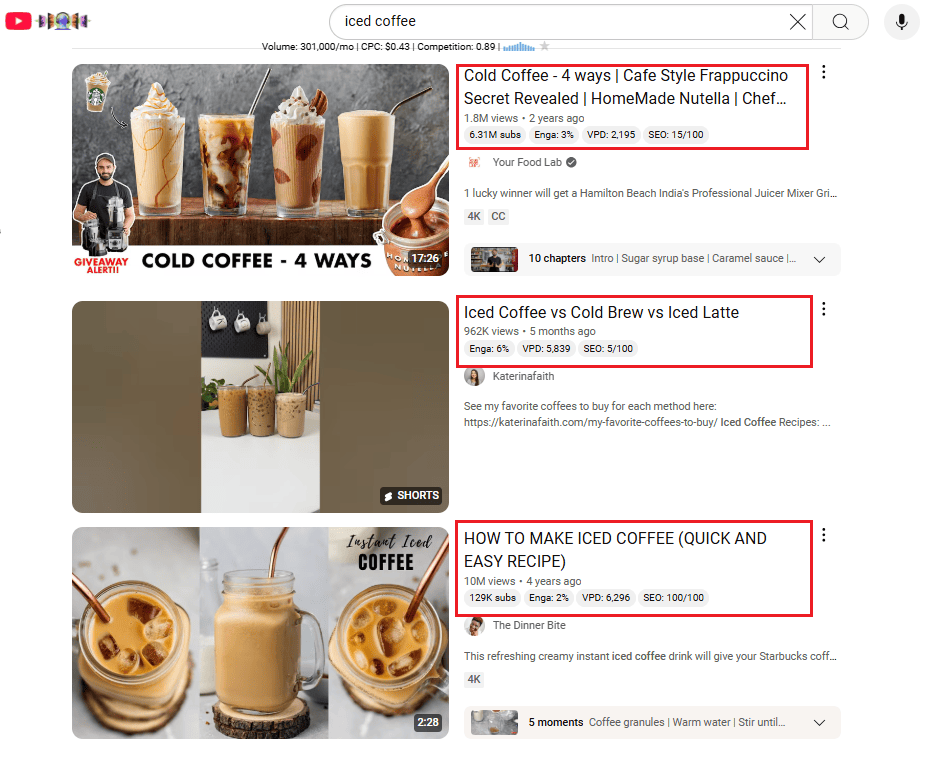
Instead of manually analyzing each ranking video, note down these metrics for 8-10 top videos and focus only on the ones with higher scores in all four areas.
This way, you’ll save time and effort while still making data-driven decisions for your YouTube keyword strategy.
6. Track Keyword Trends Over Time
Keywords Everywhere also provides trend data, which lets you track a keyword’s search volume over time.
This helps you spot emerging trends and decide whether a keyword’s popularity is stable, rising, or just a temporary spike.
For example, let’s say you’re running a fitness channel and want to create content around “home workouts.”
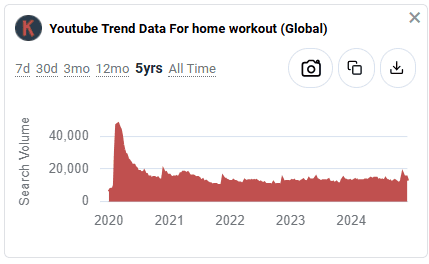
By checking the trend data, you might notice that searches for this term surged during the pandemic (2020) but have since declined.
However, a related keyword like “workout dance” or “15-minute workouts” might show consistent or growing interest.
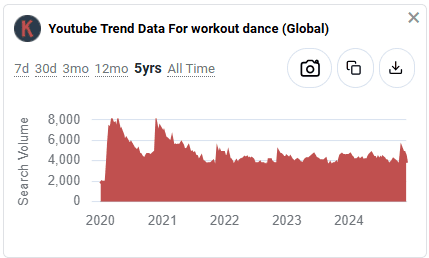
This is where trend analysis becomes crucial. Just because a keyword has a high search volume today doesn’t mean it will stay that way.
A sudden increase might be due to a seasonal trend, viral challenge, or temporary event, and jumping on a fading trend won’t do much for long-term growth.
Using Trend Data for YouTube Search, you can ensure you’re not just following the hype but actually choosing keywords that will continue to bring in views over time.
Conclusion
A keyword planner for YouTube helps you find the right search terms to optimize your videos, increase visibility, and attract more viewers.
When you pick the right keywords, your content will reach the right audience (people you’re targeting).
With so many keyword planners for YouTube out there, Keywords Everywhere stands out because it provides key insights like search volume, ranking difficulty, competition, and trend data—all directly on YouTube.
It saves time by displaying essential metrics right on the search page, helping you make informed decisions quickly.
If you want to grow your YouTube channel with effective keyword research, using Keywords Everywhere can give you a clear advantage.


